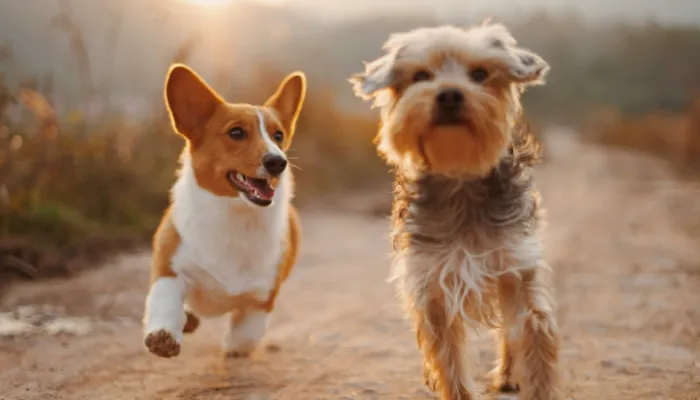Have you ever pondered, “What do dogs say when they are sad?” It’s a question that pet owners ask frequently with concern. Dogs are like humans in a way that they do not express themselves in words. Therefore, understanding their emotions takes careful monitoring of their behavior and actions.
Whether it’s a modification in body movement, sounds, energy levels, or even a combination of all these, our pets show their feelings in different ways. We’re going to explore how we can identify a dog’s sadness, and hopefully, with the help of a dog translator, we can comprehend them better!

Understanding Dog Emotions
Dogs are proven to be loyal companions and loving and caring in the lives of humans. However, like every other species, dogs have feelings and emotions, including sadness. But “What do dogs say when they are sad?” How can we effectively pinpoint the moments they are feeling down?
There are many ways through which dogs communicate their emotions, and sadness is not an exception. The most vital part of making your dog feel secure and loved is recognizing and understanding their emotions.
Answering “What do dogs say when they are sad?” requires keen observation of the dog’s physical actions and behaviors.
Common Indications of a Sad Dog
Being sad can affect a dog’s usual happy and playful attitude. Here are some behavioral changes that could indicate that a dog has sad emotions:
- Low Enthusiasm: Playtime or exercise may not interest sad dogs. Some of them will appear to be less active, preferring to rest and avoiding their usual pastimes.
- Less Willingness to Eat: Sadness can significantly affect how a dog perceives food. Not wanting to eat or only eating small portions can be one of the first signs that your dog is dealing with some sad emotions.
- Vocalizations: Dogs have a wide range of expressing their emotions. Besides simply barking, dogs may whine, whimper, or howl to show sadness or loneliness.
- Separation: There are dogs that prefer to be socially isolated when they are sad. Such dogs will try to find quiet corners of the house and may reduce interaction with other members of the family.
- Shifts in Body Language: Dogs do a lot of communicating with their body. A dejected dog may show a drooping head, ears that are not perked up, and a tail that is tucked between its legs. They may be less energetic or move in a slow and uncoordinated way.
With these behavioral changes, it is evident that when dogs are sad, they tend to alter their actions. They withdraw, are less active, or muffle, which solves the question: “What do dogs say when they are sad?”
The Adjustment of Change and Setting
Now, the real question is, “What do dogs say when they are sad?”. Is it always due to emotive reasons like loneliness or sadness? Changes in the setting also bring about a feeling of sadness. The answer is yes. Dogs are creatures of habit, and any sudden alteration in their surroundings can have an impact on their psychological state.
How Environmental Changes Affect Your Dog
Dogs love living in the same environment. It is completely normal for them to feel depressed or anxious when subjected to severe environmental changes such as moving to a new house or changing routines. Here are some causes that could lead to depression.
- Relocation: From a dog’s perspective, moving into a new house can be exhausting. The abrupt change to their space can be very disconcerting.
- Loss of a Companion: In the unfortunate event that a close friend or other household pet dies, the dog is also capable of grieving. They can display deep anguish as humans do.
- Neglect: A dog who is used to constant supervision and focus can exhibit depression-like symptoms when they begins feeling ignored.
- Changes to Routine: Leaving your dog alone for an extended duration or reducing playtime can result in the stem of anxiety or sadness within them.
The changes in the environment can greatly affect a dog’s psychological well-being. Look for behavioral changes as a clue to answer the question, “What do dogs say when they are sad?”.
What to Do If Your Dog Is Feeling Sad
Address them head-on by taking steps to alleviate their lack of enthusiasm. Where dogs go when they are sad is a question some may not know, but the actions that follow make it clear there’s a problem. Here are some steps you can take to ensure that the dog in your care stays cheerful:
1. Engagement in Activities
- Most dogs love humans, and humans, in turn, love dogs. An effective treatment would be to spend more time with your dog by engaging in some extra playing or sitting around with them. That way, they’ll feel cherished.
2. Create a Comfortable Space
- Ensure that the bedroom of the dog is a comfy zone that enables relaxation. You may add a favorite softer bed, softer blankets, or certain toys that soothe the dog.
3. Making Scheduled Routines
- Dogs are proponents of unchanged lifestyles. It is helpful to maintain normal routines around meal times, walks, and playtimes to the point of over-scheduling. Such actions reduce the chances of stress.
4. Offer Your Dog Mental Exercise
- Let them use puzzle toys or try new activities to stimulate their brain. This can help draw their mind away from their sadness and make them feel more active and happy.
5. Get a Professional Opinion
- Take the proper actions to consult a professional if your dog’s sadness continues or gets worse. Sometimes sadness manifests itself due to deeper health issues that require attention.
Knowing what dogs say when they are sad is key to turning around this distressing situation. By giving your pet your time and affection, along with some set guidelines, you can help them cope with their feelings.
How Important is Bonding
These emotional connections are one of the easiest ways to make sure that your dog is happy, the more positive the emotional connection the better. Dogs depend on people for emotional support and they do well when they are nurtured. If you have ever asked yourself, “What do dogs say when they are sad?” understand the importance of building a good rapport to be able to avoid sadness.
Ways to Strengthen Your Bond
- Positive Reinforcement: When your pup behaves well, make sure to reward him with treats, praise, or love. This allows for a trusting relationship.
- Training: Partake in playful exercises that are both enjoyable and challenging for the dog as well as strengthen the bond you already have.
- Exercise Together: An excellent method to bond with your dog is through physical activities like hiking, running, and playing fetch. Those activities elevate their spirits as well as your bond.
Cultivating the bond you have with your dog ensures they feel cared for even in their sad moments. They’ll always know they are supported. One must dispense “What do dogs say when they are sad?” and make sure to act in order to protect their emotions.
Conclusion
“What do dogs say when they are sad?” does not always bring about an easy answer. Dogs show sadness in a variety of ways including vocalizations, body language, and changes in their daily routine. Recognizing these signs and being gentle and caring can help your dog get through tough emotional situations. Being well-adjusted and responsive to their emotions makes sure that the dog will always remain happy and cared for.
